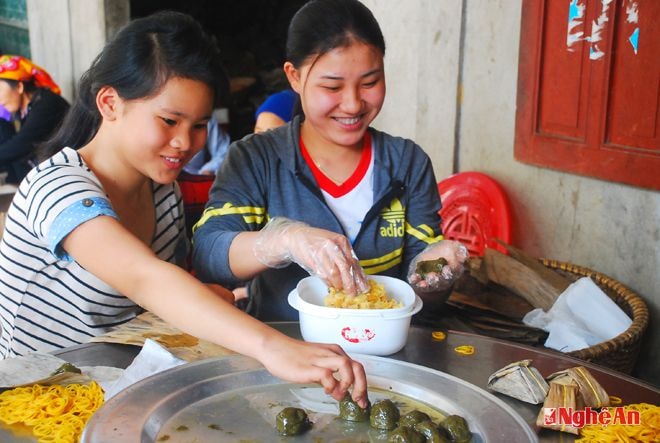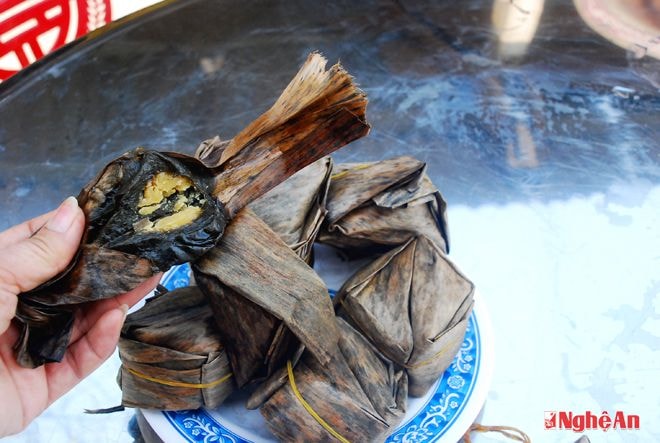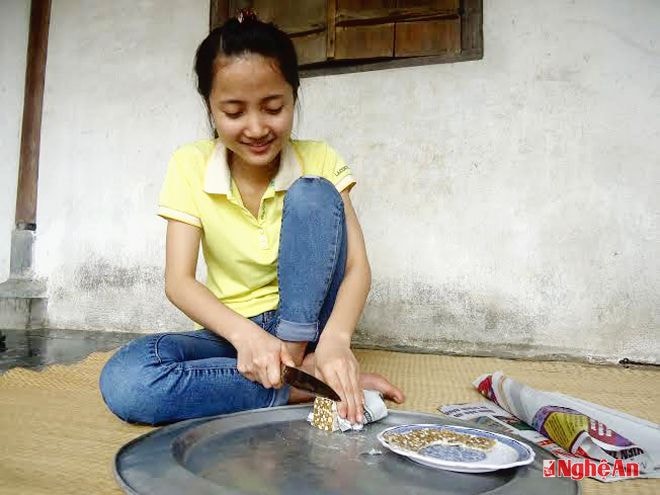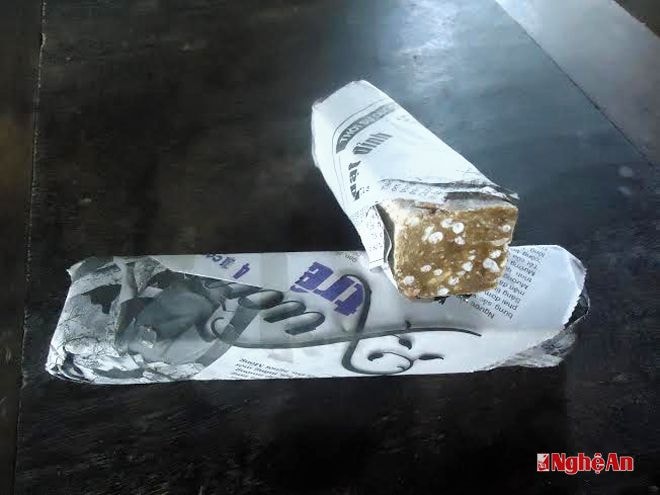The scent of cake - the soul of the countryside...
(Baonghean) - The first spring bus rolled on the long asphalt road. Outside the frosted glass window, the vast green fields and the golden sunlight on the Lam river ripples shone. "There's my hometown!" - he shouted, his lips trembling slightly in the immense emotion of longing...
 |
| Coconut women wrap gai cake. |
The car door opened, he held my hand tightly, and stepped down with emotion. The man with gray hair, who had bravely overcome many hardships, suddenly became a 5 or 7 year old boy, clumsy and moved by the loving things that were present before his eyes. He kept calling out “my hometown”! “My hometown” in him was the land of Dua Tuong Son (Anh Son) - the land of hot Lao wind in the summer, the scorching sun on the dry land that he had told me many times - a daughter-in-law from the North who had never had the opportunity to enjoy that “specialty” of nature. He said that his childhood was spent herding buffaloes, cutting grass, wearing only a short shirt pulled up to the navel and “spring” pants all year round, when the buffaloes were driven out to the field, the whole group of children in the village shouted to each other and jumped into the cool water. He pointed far away, the Lam River of his hometown, rolling in the shimmering afternoon sunlight, as if rolling up all the stirring emotions in the hearts of those far from home. Where there is no river, I could not understand why he could miss his hometown river so much? The river is simple yet great, he compared it to a mother's tolerant heart... The sweet river bathed in foolishness, soothed many hidden feelings...
The river has become a spiritual symbol, fostering small and great material values that weigh heavily on the hearts of those far from home. He said that his hometown of Dua is famous far and wide, because the sweetness of the Lam River is wrapped in the rustic flavor of the rustic sticky rice cake. He leisurely led me up and down Doc Dua. There, the locals crowded the spacious shops, making and selling that rustic specialty. Busy buses along Highway 7 occasionally stopped, passengers hurriedly got off to buy sticky rice cake as gifts. His hometown this season has begun to be very hot and sunny, but Doc Dua is protected by two mountain wings, always feeling the cool breeze from the river...
The cake has a rough and thorny name, but when picked up, it is so light and small that it seems as if it could not be simpler and more rustic. The leaves wrapping the cake are dark brown and peaceful, like the brown shirt of her grandmother, of her mother; like the poetic color of the soil on the field... Seeing the daughter-in-law from the North still talking about cakes, Ms. Bui Thi Ha - the owner of a roadside cake shop waved her over. For half of her life, Ms. Ha was born and raised here, for the same number of months and years, the flavor of the sticky rice cake entwined her soul, fostering her love for her hometown and her passion for spreading the hometown specialty to all visitors from far away. Her family's sticky rice cake making facility was bustling with work at the beginning of the year, with loud voices and laughter. "Talking and laughing to relieve the fatigue, but in reality, making a sticky rice cake requires many hard steps!" - Ms. Bui Thi Ha shared.
The small gai cake, imbued with the love of the land and people in this beautiful landscape. The main ingredients to make the cake are purely the familiar flavors of the countryside: white sticky rice from the rice fields, apricot sugar from the Lam River, green beans from the Anh Son soil, and even the ramie leaves dyed with the characteristic brown-black color of the cake, and the banana leaves that wrap the outside... All of these ingredients are carefully selected, such as banana leaves, which must be picked when they are naturally dry on the tree, so that the leaves dry but are not brittle, still have a bit of soft moisture so that the cake does not stick to the flour and is loose in the hand. The most difficult step is coloring the cake. Ms. Bui Thi Ha said that in the past, there were still many ramie trees in nature, but gradually, the demand for trade increased, people exploited them to make cakes, so they gradually became scarce. To have the key ingredients for this specialty, establishments must grow their own ramie trees. Pick the ramie leaves, wash them, drain them, put them in a pot, cover them with water and boil them for a full day. At that time, the fresh green ramie leaves had turned dark brown. That warm color, together with fragrant sticky rice, green bean paste and sweet fresh coconut, had made the "reputation" of the gai cake of the Coconut land.
 |
| Coconut Rice Cake. |
Standing next to me watching the cake making process, occasionally joining in the jokes of dozens of workers with nimble hands, he whispered, missing the countryside in his memories! That countryside, with his grandmother, mother, sister, the cold winters, waking up early to soak beans, pound leaves, and make early cakes for the children in the house who were wrapped in warm blankets. How many winter mornings in the past, he woke up to the fragrant aroma of hot sticky rice cake, warming the heart of a whole childhood. For some people, hometown is the streets, for others it is the fields, and for him, it is the flavor of those simple dishes...
Once again, I heard him tell the story of his life. The story that we all knew, but why, standing on this land, brought up such touching emotions. There, there was the image of a poor boy, not having enough food, not enough clothes to wear, but extremely studious. The only gift he received from his grandmother and mother for each achievement in studying, was rustic snacks. Sometimes it was gai cake, sometimes honey cake... If gai cake is a specialty of the Anh Son Coconut land - his paternal hometown, then honey cake is a specialty of his hometown Nam Dan - his maternal hometown. Two rustic cakes crystallized from the Lam stream, the ingredients made from the products of the Nghe coast, for decades, still linger in the souls of expatriates.
 |
| Honey cake - rustic specialty of Nam Dan homeland. |
He said that the honey cake has the sweetness of molasses, the stickiness of sticky rice and the aroma of ginger, sesame, banana oil... Just like the gai cake, making honey cake is very elaborate, from the selection of ingredients to the processing method, so the cake is often made by the skillful, steady and careful hands of the elderly in the family. Batches of honey cake are usually made in early spring and the new year. Every year around the 23rd of Tet, the cake maker will prepare 2 portions of delicious sticky rice, 1 portion is reserved for the children to take to pop into fluffy grains, and 1 portion is ground into flour. I looked deep into his eyes, still sparkling with joy when remembering the memories of my childhood, with my friends holding the sticky rice package my mother gave me, cheering on the long, cold dirt road. The popcorn kernels crackled in the oven, the rice bran gently floated up, giving off a faint scent of the rice fields... Bringing the finished product back, at the end of the lane, I could hear the sound of my grandmother pounding ginger, the spicy scent of ginger rising in the wind. The ginger was old ginger from the garden, aged in the cool brown soil for a year. That ginger, along with roasted peanuts and sesame, made up half of the key ingredients of the delicious honey cake.
 |
The deliciousness of the honey cake lies in the molasses. The red sugarcane along the Lam Giang riverbank is plump and sweet with sugar. The sugarcane is cooked into molasses, which enhances the flavor of the cake. Boil the molasses, slowly add crushed ginger, then the mixture is mixed with the sticky rice flour, peanuts and sesame. At this time, the baker must use chopsticks to stir it well, adding a few drops of banana oil to enhance the flavor. The fragrance permeates the small house... That fragrance follows the children of his hometown flying around the village during the Tet festival; the lingering scent in the old, worn-out backpack follows the soldier to the university lecture hall; and until now, it still lingers in the soul. The man has traveled for more than half of his life, eating out, eating porridge from the South to the North, tasting all kinds of delicious and strange dishes from all over, but still yearns for the rustic scent of his hometown to the point of not being able to linger any longer for the upstream trip.
Gai cake from my paternal hometown, Ong cake from my maternal hometown, for him and me, have long been a sign of hometown imprinted in our subconscious. They are not simply delicious dishes, but also the nostalgia for a countryside, the scent of the fields, and childhood memories. We have enjoyed those hometown gifts in many big cities across the country, gifts made by the hands of Nghe people far from home, missing their hometown and putting it into the products. However, nowhere, never can those gifts bring the complete rustic flavor that is deep in the feeling. Those city cakes are inferior to the delicious dishes in our memories because they lack the ingredients from our hometown. Those ingredients create the culinary heritage of the Nghe countryside full of sun and wind but full of affection...
Phuong Chi - Nguyen Xoai






